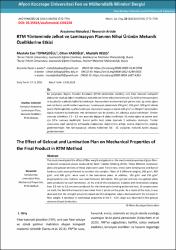RTM yönteminde jelkot ve laminasyon planının nihai ürünün mekanik özelliklerine etkisi
Citation
Topbaşoğlu, M. C. , Kaboğlu, C. & Keleş, M. (2023). RTM Yönteminde Jelkot ve Laminasyon Planının Nihai Ürünün Mekanik Özelliklerine Etkisi . Afyon Kocatepe Üniversitesi Fen Ve Mühendislik Bilimleri Dergisi , 23 (3) , 772-779 . DOI: 10.35414/akufemubid.1201258Abstract
Bu çalışmada, Reçine Transfer Kalıplama (RTM) yöntemiyle üretilmiş cam fiber takviyeli kompozit plakalarda elyaf ağırlığının ve jelkotun mekanik özelliklere etkisi incelenmiştir. Üç farklı laminasyon planı ve bu planların jelkotlu halleri kullanılmıştır. Numunelerin incelenmesi için çekme testi, üç nokta eğme testi ve Barcol sertlik testleri yapılmıştır. Laminasyon planlarında 300 g/m2 , 450 g/m2 , 600 g/m2 olmak üzere 3 farklı ağırlıkta elyaf kullanılmıştır. Ayrıca laminasyon arasında 180 g/m2 ve 250 g/m2 polipropilen köpük malzeme kullanılmıştır. Her laminasyon için bir jelkotlu, bir jelkotsuz plaka üretilmiştir. Üretim sonunda kalınlıkları 2.5 – 3.2 mm arasında değişen 6 plaka üretilmiştir. Üç nokta eğme ve çekme testi için 10’ar numune kesilmiştir, Barcol sertlik testi plaka üzerinde 5 noktadan alınmıştır. Testler sonucunda elyaf ağırlığının artmasıyla mukavemet değerlerinin arttığı, uzama değerlerinin azaldığı gözlemlenmiştir. Her laminasyonun jelkotlu hallerinde %5 - 15 aralığında mekanik özellik düşüşü gözlemlenmiştir. This study investigated the effect of fiber weight and gelcoat on the mechanical properties of glass fiberreinforced composite plates produced by Resin Transfer Molding (RTM). Three different lamination
plans and gelcoat versions of these plans were used. Tensile test, three-point bending test and Barcol
hardness tests were performed to examine the samples. Fibers of 3 different weights, 300 g/m2
, 450
g/m2
, and 600 g/m2
, were used in the lamination plans. In addition, 180 g/m2 and 250 g/m2
polypropylene core material was used between lamination. One gelcoat and one non-gelcoat plate
were produced for each lamination. At the end of the production, 6 plates with thicknesses ranging
from 2.5 mm to 3.2 mm were produced. For the three-point bending and tensile test, 10 samples were
cut each, the Barcol hardness test was taken from 5 points on the plate. As a result of the tests, it was
observed that the strength values increased and the elongation values decreased with the increase in
fiber weight. A decrease in mechanical properties in the 5 - 15% range was observed in the gelcoat
versions of each lamination.
Source
Afyon Kocatepe Üniversitesi Fen ve Mühendislik Bilimleri DergisiVolume
23Issue
3Collections
- Cilt 23 : Sayı 3 [25]



















